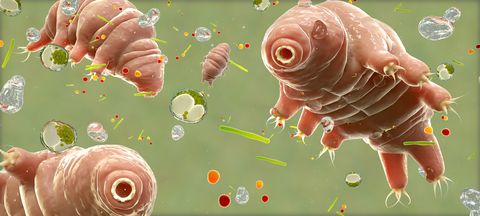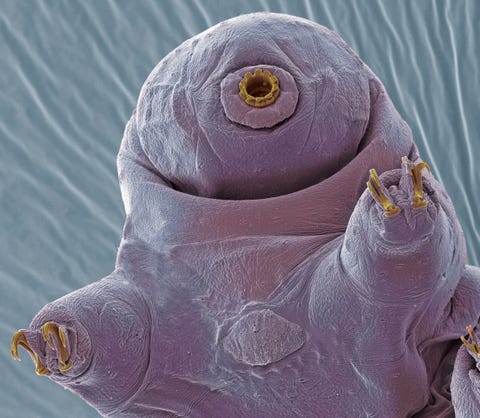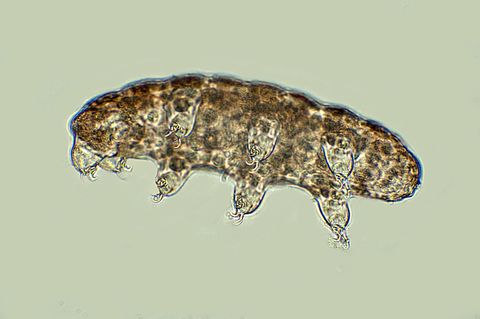Tardigrades are one of the most fascinating creatures on Earth—and the moon. In 2019, the Israeli spacecraft Beresheet crashed on the moon, spilling thousands of the dehydrated tardigrades that scientists loaded onto the lander (along with human DNA samples).
The tardigrades were in “tun” form, a dormant state where they shrivel up into a ball, expel most of the water in their bodies, and lower their metabolism via cryptobiosis until they enter an environment better suited for sustaining life. They can exist like this for decades. They’re also pretty hardy and can endure even the harshest environments, including subzero temperatures—and, you know, lunar crash landings.
We talked to leading researchers to find out what makes these little “water bears” so amazing. Here are our seven favorite facts about tardigrades, according to the latest research.
1) Tardigrades are everywhere.

Tardigrades are a class of microscopic animals with eight limbs and strange, alien-like behavior. William Miller, a leading tardigrade researcher at Baker University, says they are remarkably abundant. Hundreds of species “are found across the seven continents; everywhere from the highest mountain to the lowest sea,” he says. “Many species of tardigrades live in water, but on land, you find them almost everywhere there’s moss or lichen.”
In 2007, scientists discovered these microscopic critters can survive an extended stay in the cold, irradiated vacuum of outer space. A European team of researchers sent a group of living tardigrades to orbit the earth on the outside of a FOTON-M3 rocket for 10 days. When the water bears returned to Earth, the scientists discovered that 68 percent lived through the ordeal.

Although tardigrades are unique in their ability to survive in space, Miller insists there is no reason to believe they evolved for this reason or—as a misleading VICE documentary has implied—that they are of extraterrestrial origin. Rather, the tardigrade’s space-surviving ability is the result of a strange response they’ve evolved to overcome an earthly life-threatening problem: a water shortage.
Land-dwelling tardigrades can be found in some of the driest places on Earth. “I’ve collected living tardigrades from under a rock in the Sinai desert, in a part of the desert that hadn’t had any record of rain for the previous 25 years,” Miller says. Yet these are technically aquatic creatures, and require a thin layer of water to do pretty much anything, including eating, having sex, or moving around. Without water, they’re about as lively as a beached dolphin.
2) Tardigrades can pause their biological clock.

But land-dwelling tardigrades have evolved a bizarre solution to living through drought: When their environment dries up, so do they. Tardigrades will enter a state called desiccation, in which they shrivel up, losing all but around three percent of their body’s water and slowing their metabolism down to an astonishing 0.01 percent of its normal speed—a metabolic state known as cryptobiosis. In this state, the tardigrade just persists, doing nothing, until it’s inundated with water again. When that happens, the creature pops back to life like a re-wetted sponge and continues onward as if nothing had happened.
This content is imported from youTube. You may be able to find the same content in another format, or you may be able to find more information, at their web site.

What’s even more astonishing is that tardigrades can survive being in this strange state for more than a decade. According to Miller, a few researchers believe some species of tardigrades might even be able to survive desiccation for up to a century. Yet the average lifespan of a (continuously hydrated) tardigrade is rarely longer than a few months.
“It sounds quite strange,” says Miller, “that even though these tardigrades only live for a few weeks or months, that lifetime can be stretched over many, many years.”
Similarly, tardigrades can also survive being frozen. A new study published in Journal of Zoology in September 2022 shows that tardigrades exposed to freezing temperatures entered cryptobiosis and lived longer than those who never entered this state during their lives.

Out of a total of 716 tardigrades, those that were periodically frozen became “sleeping beauties,” living around twice as long as the control group. The oldest tardigrade stuck around for 169 days, with 94 days at room temperature. In the control group, which stayed warm, the oldest tardigrade lived for 93 days.
“During inactive periods, the internal clock stops and only resumes running once the organism is reactivated,” explains zoologist Ralph Schill, one of the researchers. “So, tardigrades, which usually only live for a few months without periods of rest, can live for many years or even decades.”
3) Tardigrades probably can’t see in color.

Recent research from the Genome Biology and Evolution journal reports that the resilient little critters don’t have the same opsins (light-sensitive, photoreceptive proteins) as animals who use their eyes to see color. One of the tardigrade species (Ramazzottius variornatus) that was analyzed in this study didn’t have eyes at all but did have active opsins. Another species (Hypsibius exemplaris) did have eyes, but their opsins didn’t respond to light stimuli—a necessary feature for color vision. It’s technically still possible that tardigrades can see some color, but it’s more likely that they see things in black and white. Their eyes are very simple, after all. Further research is needed to determine how their vision works.
4) Tardigrades can survive the harshest atmospheres.

In its desiccated state, the tardigrade is ridiculously, almost absurdly resilient. Laboratory tests have shown that tardigrades can endure both an utter vacuum and intense pressures more than five times as punishing as those in the deepest ocean. Even temperatures up to 300 degrees Fahrenheit and as low as minus 458 degrees Fahrenheit (just above absolute zero) won’t spell out the creature’s doom.
But the exact source of its resilience is a mystery, says Emma Perry, a leading tardigrade researcher at Unity College in Maine. “In general, we know very little about how this species functions, especially when we’re talking about the molecular level.”

There are clues. Scientists have learned that when the tardigrade enters its desiccated state, “it replaces some of its cell contents with a sugar molecule called trehalose,” Perry says.
Researchers believe this trehalose molecule not only replaces water, but also in some cases can physically constrain the critter’s remaining water molecules, keeping them from rapidly expanding when faced with hot and cold temperatures. This is important, because expanding water molecules (like what happens when you get frostbite) can mean instant cellular death for most animals.
5) Even space radiation is no match for tardigrades.

Space is deadly, and not just because of the vacuum. Outside our protective atmosphere there is killer radiation caused by distant supernovae, our sun, and other sources. Space radiation comes in the form of harmful charged particles that can imbed in the body of animals, ripping apart molecules and damaging DNA faster than it can be repaired.
But here, too, the tardigrade seems oddly prepared for life in space. According to Peter Guida, the head of NASA’s space radiation laboratory, one of the biggest radiation concerns for astronauts (and space-bound tardigrades) is a set of molecules called reactive oxygen species. Ionizing radiation enters the body and bores into wayward molecules that contain oxygen. In simple terms, those newly irradiated molecules then troll through the body causing all sorts of harm.

Tardigrades, in their desiccated state, produce an abnormal amount of antioxidants (yes, these actually exist outside the health-food world), which effectively neutralize those roaming, evil reactive oxygen species. Partly because of this talent, tardigrades have been found to withstand higher radiation doses with far greater success than researchers would otherwise believe they should.
The reason that tardigrades would have evolved to survive high radiation doses is a mystery, too. However, Miller points to a leading theory: Perhaps tardigrades evolved to be swept up by the wind and survive in the earth’s atmosphere—which would explain not only their hardiness, but also why they’re found all over the world.
6) Still, tardigrades aren’t completely invincible.

There might be one thing tardigrades are not so well-equipped to handle: high temperatures over a prolonged period of time, per a study published in Scientific Reports in January 2020. The study revealed that this temperature-based Achilles’ heel also extends to when tardigrades are in their protective tun states.
Researchers studied Ramazzottius varieornatus, a species of tardigrade, in tun state and noted nearly 50 percent of the tardigrades exposed to 181 degrees Fahrenheit over the course of an hour perished. Active tardigrades—that is, those not in tun state—fared even worse.
These temperature experiments show that, given time, most tardigrades can adjust to intense temperature fluctuations: The tardigrades who had an hour to acclimate to intense heat faced higher mortality rates, compared to those who had a full 24 hours.

“Tardigrades can survive pressures that are comparable to those created when asteroids strike Earth, so a small crash like this is nothing to them,” Lukasz Kaczmarek, an expert on tardigrades, told The Guardian.
So what does this mean for us? If humans could replicate cryptobiosis in the way tardigrades do, we’d live far longer than the average life expectancy. According to Kaczmarek, when a tardigrade enters the tun state, it doesn’t age. It becomes dormant at one month old and can wake up years later and still biologically be the same age.
“It may be that we can use this in the future if we plan missions to different planets, because we will need to be young when we get there,” said Kaczmarek.
7) Some tardigrades lay spiked eggs.

Various Dactylobiotus ovimutans eggs are shown, each displaying its own custom morphology.
The ever-mysterious, alien-like creatures have presented scientists with yet another quandary: What’s the deal with a newly discovered tardigrade species that can lay spiked eggs?
In a June 2020 paper published in Scientific Reports, scientists reveal that Dactylobiotus ovimutans, the new species, displayed a “range of eggshell morphologies” despite the fact that “the population was cultured under controlled laboratory condition.”
The researchers believe an “epigenetic factor” could be causing the range of shapes and features seen on the D. ovimutans eggs. But the mystery still remains: Why has D. ovimutans turned to epigenetics (the activation/deactivation of genes that has no affect on an organism’s DNA sequence) when it comes to their offspring?

William Herkewitz is a science and technology journalist based in Berlin, Germany. He writes about theoretical physics, AI, astronomy, board games, brewing and everything in between.
Daisy writes for Runner’s World, Bicycling, and Popular Mechanics. She received her MA from ESU and loves all things pop culture, dinosaurs, cooking, and reading.




